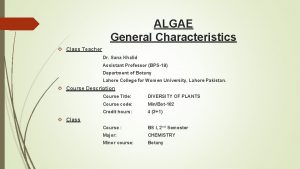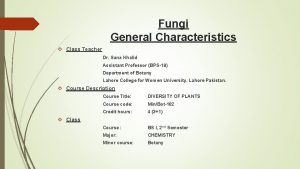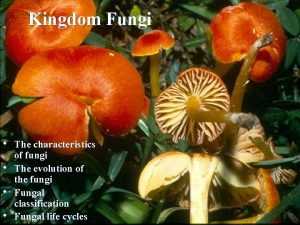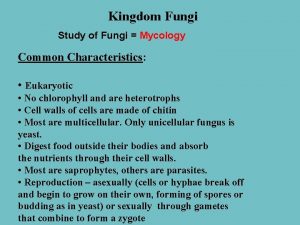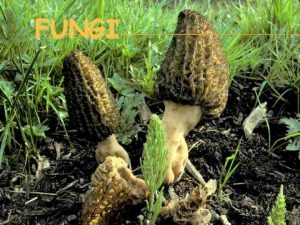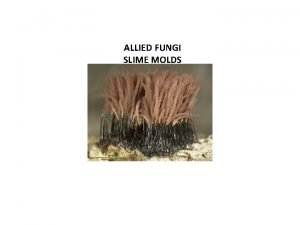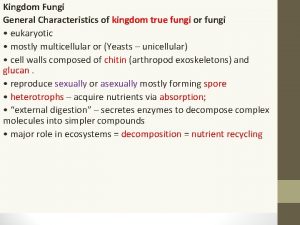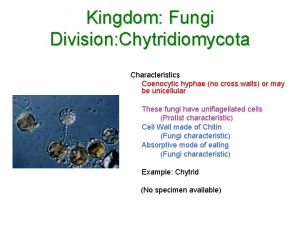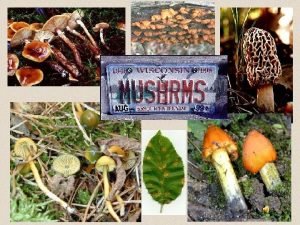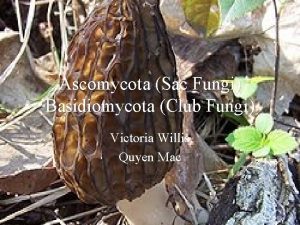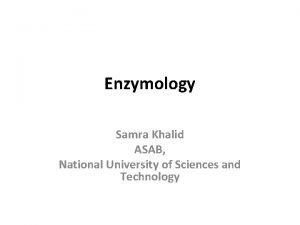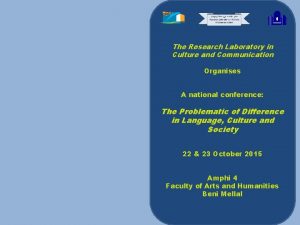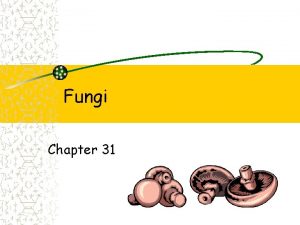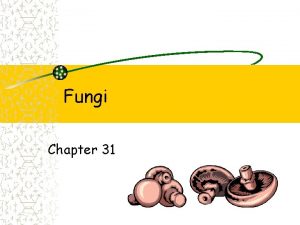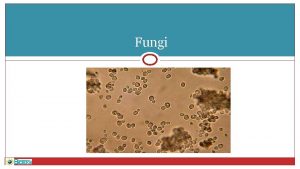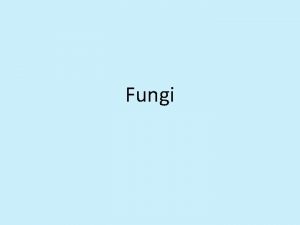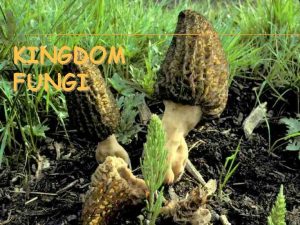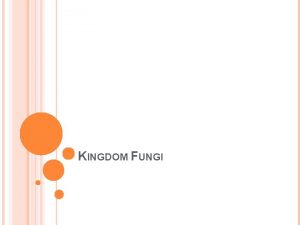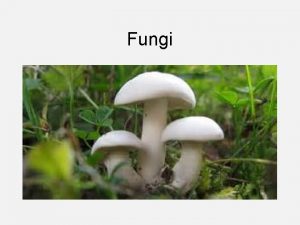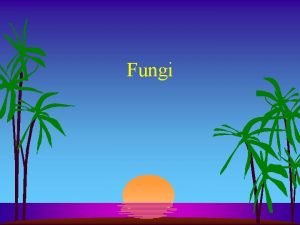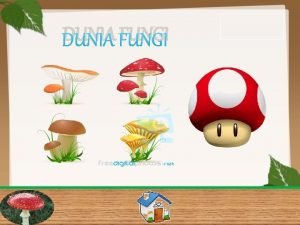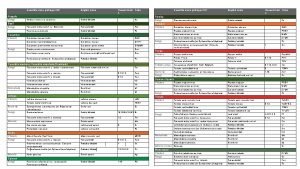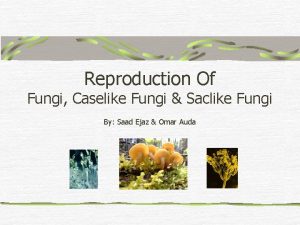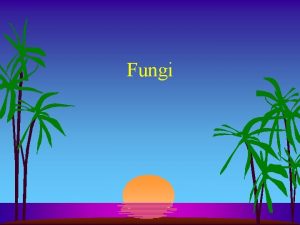Fungi General Characteristics Class Teacher Dr Sana Khalid



























- Slides: 27

Fungi General Characteristics Class Teacher Dr. Sana Khalid Assistant Professor (BPS-19) Department of Botany Lahore College for Women University, Lahore Pakistan. Course Description Course Title: DIVERSITY OF PLANTS Course code: Min/Bot-102 Credit hours: 4 (3+1) Course : BS I, 2 nd Semester Major: CHEMISTRY Minor course: Botany Class


Fungi are achlorophyllous, heterotrophic, eukaryotic thallophytes. They are non-green in color with the capacity to live in all kinds of environments. They generally feed on dead and decaying organic matter. General characters of Fungi are found in all types of environments where organic materials are available. For examples, water, air, dead and decaying organic matter, living organisms. Some fungi are unicellular. The thallus of the fungi is long and tubular with filamentous branches called as hyphae. Hyphae are aseptate, coenocytic, uni-, di- or multinucleate. The mass of interwoven hyphae is called mycelium. Mycelium may be unicellular or multicellular. The cells of fungi have definite cell wall mainly made up of chitin. Chitin is a nitrogenous material containing polysaccharide. Other components of the fungal cell wall may be cellulose-glycogen, cellulose-glucan (found in oomycetes), Cellulose-chitin, chitin-chitosan (found in zygomycetes), Chitin-glucan (found in ascomycetes and basidiomycetes) etc. Fungi are eukaryotic and they do not have plastids. As fungi do not have chlorophyll, they cannot perform photosynthesis. They obtain their nourishment from the environment by extracellular digestion and absorption of digested food material. So they are known as heterotrophs.

Fungi live as saprophytes on dead and decaying organic matter, as parasites on/inside living organisms. Some fungi grow in symbiotic relationship with algae and form lichens. Some of the fungi grow in close association with the roots of the vascular plants forming mycorrhizae. The reserve food material of the fungi is glycogen, fats or lipid globules. Fungi reproduce vegetatively by fragmentation, budding and fission. During favorable conditions, they reproduce asexually by spores. The asexual spores are called sporangiospores and conidia. The sporangiospores may be zoospores or aplanospores. Zoospores are flagellated spores with one or two flagella. Aplanospores are non-flagellated spores. Sexual reproduction in fungi is through gametes and is carried out with the help of planogametic copulation, gametangial contact, gametangial copulation, spermatization or somatogamy. Fungi show progressive reduction of sexuality Fungi exhibit asexual haplontic, haplontic-dikaryotic, haplo-diplontic or diplontic life cycle. Source: https: //www. studyandscore. com/studymaterial-detail/general-characters-of-fungi

Oomycetes-Albugo Scientific classification Phylum: Heterokontophyta Class: Oomycota Order: Albuginales Family: Albuginaceae Genus: Albugo candida, on Capsella bursapastoris

Summary Albugo is a genus of plant-parasitic oomycetes. Those are not true fungi (Eumycota), although many discussions of this organism still treat it as a fungus. The taxonomy of this genus is incomplete, but several species are plant pathogens. Albugo is one of three genera currently described in the family Albuginaceae, the taxonomy of many species is still in flux. This organism causes white rust or white blister diseases in above-ground plant tissues. While these organisms affect many types of plants, the destructive aspect of infection is limited to a few agricultural crops, sprouts, cabbages, Chinese including: beets (garden and sugar), Brussels cabbage, cauliflower, collards, garden cress, kale, lettuce, mustards, parsnip, radish, horseradish, rapeseed, salsify (black or white), spinach, sweet potatoes, turnips, watercress, and perhaps water-spinach (White Rusts of Vegetables, 1990).

White rust plant diseases caused by Albugo fungal-like pathogens should not be confused with White Pine Blister Rust, Chrysanthemum white rust or any fungal rusts, all of which are also plant diseases but have completely different symptoms and causal pathogens. Symptoms of white rust caused by Albugo typically include yellow lesions on the upper leaf surface and white pustules on the underside of the leaf. The pathogen is spread by wind, water, and insects. Management includes use of resistant cultivars, proper irrigation practices, crop rotation, sanitation, and chemical control. White rust is an important economic disease, causing severe crop losses if not controlled. Hosts and Symptoms: White rust pathogens create chlorotic (yellowed) lesions and sometimes galls on the upper leaf surface and there are corresponding white blister-like dispersal pustules of sporangia on the underside of the leaf. Species of the Albuginaceae deform the branches and flower parts of many host species. Host species include most if not all plants in the family Brassicaceae, common agricultural weeds, and those specified below (White Rusts of Vegetables, 1990).

Disease cycle White rust is an obligate parasite. This means it needs a living host to grow and reproduce. The Albuginaceae reproduce by producing both sexual spores (called oospores) and asexual spores (called sporangia) in a many-stage (polycyclic) disease cycle. The thick-walled oospores are the main overwintering structures, but the mycelium can also survive in conditions where all the plant material is not destroyed during the winter. In the spring the oospores germinate and produce sporangia on short stalks called sporangiophores that become so tightly packed within the leaf that they rupture the epidermis and are consequently spread by the wind. The liberated sporangia in turn can either germinate directly with a germ tube or begin to produce biflagellate motile zoospores. These zoospores then swim in a film of water to a suitable site and each one produces a germ tube - like that of the sporangium - that penetrates the stoma. When the oomycete has successfully invaded the host plant, it grows and continues to reproduce.

Environment Favorable conditions for the dispersal and consequent infection of white rust from diseased to healthy plants are most common in the autumn and spring seasons. This pathogen prefers cool, moist conditions for the spread and formation of new infections. Conversely, it rarely infects in warm, dry conditions. Albugo is very temperature sensitive, with the optimal temperature range for infection between 55 to 77 °F (13 to 25 °C). The likelihood of germination and infection is considerably lower if temperatures deviate too far outside this optimum range (White Rusts of Vegetables, 1990). Light rain or irrigation lasting for extended periods of time is also ideal for disease development. Leaf surfaces need to remain wet for at least 2 to 3 hours to ensure infection by the pathogen. White rust ranges worldwide and is able to survive varying weather conditions due to its production of multiple spore types (White Rusts of Vegetables, 1990).

Management Controlling white rust is very difficult due to the nature of the 'Albugo' pathogen. The method of control is tailored to specific crops and production systems. This is why identification of specific hosts (crops and possible weeds) is necessary to determine range and location of control methods. Albugo proliferates in wet and moist conditions so movement through infected fields should be limited after spore maturation in these conditions to limit spread. Minimizing irrigation in cool and moist seasons as well as eliminating windbreaks to allow faster leaf drying can be beneficial. When infection is recognized, systemically infected plant material (including culled crops) should be completely removed and destroyed. Fields should be inspected every 7– 14 days to remove additional material and monitor spread. On root crops, infected leaf removal either by mowing or plowing prior to harvest will limit the spread of the pathogen during harvest. Any susceptible plants or weeds should be mowed or eliminated to reduce spread (White Rusts of Vegetables, 1990). Both conventional and organic fungicides are available and could be used to limit spread and yield losses during the spring, early summer and fall on crops and susceptible neighboring plants. Each of the 17 specific races of the white rust pathogen affects different plants so monitoring is essential as much as possible to limit overuse and cost of fungicide treatments. Common OMRI fungicides include sulphur, copper oxide, rosemary oil, and azadirachtin products (Biorationals, 2018). ommon conventional fungicides include mefenoxam and fosetyl-aluminum products (UC-IPM, 2012).

There are some resistant and partially resistant varieties which are necessary in landscapes where white rust is present. Long-term white rust persistence in fields is not an issue with all crops or in all states; however, non-susceptible crop rotation in infected fields for at least three years is widely recommended to limit establishment and wider dispersal of this pathogen from plant debris, soil, and perennial root material. This pathogen can eliminate viable production of susceptible crops in specific fields indefinitely if infection is widespread over many years (White Rusts of Vegetables, 1990). Importance White rust can be a devastating disease on many important agricultural crops throughout the world. Seventeen races of white rust have been identified worldwide, each with a high level of host specificity. White rust is an economically important foliar disease, causing substantial yield losses and eventual death of various crops. Yield losses of up to 20 percent have been recorded in canola fields, and white rust is considered the most important foliar disease of Brassicaceae species in Australia (Diseases — Canola, 2018).

References White Rusts of Vegetables" Archived 2013 -12 -28 at the Wayback Machine (PDF), RPD No. 960, Univ. of Illinois Extension, uiuc. edu, September 1990. "Biorationals - Ecological Pest Management Database - ATTRA - National Sustainable Agriculture Information Service". attra. ncat. org. Retrieved 5 September 2018. "UC IPM: UC Management Guidelines for white rust on Cole Crops" (r 108101411), ipm. ucdavis. edu, November 2008. Retrieved on 2012 -11 -02. "Diseases — Canola". www. canola. okstate. edu. Retrieved 5 September 2018.

Ascomycetes-Penicillium

Scientific classification Kingdom: Fungi Division: Ascomycota Class: Eurotiomycetes Order: Eurotiales Family: Trichocomaceae Genus: Penicillium Link (1809)

Penicillium ascomycetous fungi are of major importance in the natural environment as well as food and drug production. Some members of the genus produce penicillin, a molecule that is used as an antibiotic, which kills or stops the growth of certain kinds of bacteria. Other species are used in cheesemaking. According to the Dictionary of the Fungi (10 th edition, 2008), the widespread genus contains over 300 species (Kirk, 2008). Taxonomy The genus was first described in the scientific literature by Johann Heinrich Friedrich Link in his 1809 work Observationes in ordines plantarum naturales, writing "Penicillium. Thallus e floccis caespitosis septatis simplicibus aut ramosis fertilibus erectis apice penicillatis", where penicillatis referred to "pencil-like" (referring to a Camel's hair pencil brush (Visagie et al. , 2014; Link, 1809). b. Link included three species—P. candidum, P. expansum, and P. glaucum—all of which produced a brushlike conidiophore (asexual fruiting structure). The common apple rot fungus P. expansum was selected as the type species (Samson and Pitt, 1985). In a 1979 monograph, John conidiophore morphology and I. Pitt branching divided Penicillium into four subgenera based on pattern: Aspergilloides, Biverticillium, Furcatum,

Characteristics The thallus (mycelium) consists of highly branched networks of multinucleated cells located on a septum lacking hyphae that is often colorless. Conidiophores are at the end of each branch accompanied by green spherical constricted units called conidiospores. These individual units play a significant role in reproduction; conidiospores are the main dispersal route of the fungi. Sexual reproduction involves the production of ascospores, commencing with the fusion of an archegonium and an antheridium, with sharing of nuclei. The irregularly distributed asci contain eight unicellular ascospores each. Economic value Several species of the genus Penicillium play a central role in the production of cheese and of various meat products. To be specific, Penicillium molds are found in Blue cheese. Penicillium camemberti and Penicillium roqueforti are the molds on Camembert, Brie, Roquefort, and many other cheeses. Penicillium nalgiovense is used in soft mold-ripened cheeses, such as Nalžovy (ellischau) cheese, and to improve the taste of sausages and hams, and to prevent colonization by other molds and bacteria (Mrázek et al. , 2015; Marianski, S. ; Marianski, 2009).

In addition to their importance in the food industry, species of Penicillium and Aspergillus serve in the production of a number of biotechnologically produced enzymes and other macromolecules, such as gluconic, citric, and tartaric acids, as well as several pectinases, lipase, amylases, cellulases, and proteases. Some Penicillium species have shown potential for use in bioremediation, more specifically mycoremediation, because of their ability to break down a variety of xenobiotic compounds (Leitão, 2009). Penicillium also prevents bacteria from affecting the body The genus includes a wide variety of species molds that are the source molds of major antibiotics. Penicillin, a drug produced by P. chrysogenum (formerly P. notatum), was accidentally discovered by Alexander Fleming in 1929, and found to inhibit the growth of Gram-positive bacteria (see beta-lactams). Its potential as an antibiotic was realized in the late 1930 s, and Howard Florey and Ernst Chain purified and concentrated the compound. The drug's success in saving soldiers in World War II who had been dying from infected wounds resulted in Fleming, Florey and Chain jointly winning the Nobel Prize in Medicine in 1945 (Rifkind and Freeman, 2005). Griseofulvin is an antifungal drug and a potential chemotherapeutic agent (Singh, 2008) that was discovered in P. griseofulvum (De Carli and Larizza, 1988). Additional species that produce compounds capable of inhibiting the growth of tumor cells in vitro include: P. pinophilum (Nicoletti et al. , 2009 a), P. canescens (Nicoletti et al. , 2009 b) and P. glabrum.

Reproduction Although many eukaryotes are able to reproduce sexually, as much as 20% of fungal species had been thought to reproduce exclusively by asexual means. However recent studies have revealed that sex occurs even in some of the supposedly asexual species. For example, sexual capability was recently shown for the fungus Penicillium roqueforti, used as a starter for blue cheese production (Ropars et al. , 2012). This finding was based, in part, on evidence for functional mating type (MAT) genes that are involved in fungal sexual compatibility, and the presence in the sequenced genome of most of the important genes known to be involved in meiosis. Penicillium chrysogenum is of major medical and historical importance as the original and present-day industrial source of the antibiotic penicillin. The species was considered asexual for more than 100 years despite concerted efforts to induce sexual reproduction. However, in 2013, Bohm et al. (2013) finally demonstrated sexual reproduction in P. chrysogenum. These findings with Penicillium species are consistent with accumulating evidence from studies of other eukaryotic species that sex was likely present in the common ancestor of all eukaryotes (Malik et al. , 2008). Furthermore, these recent results suggest that sex can be maintained even when very little genetic variability is produced. Prior to 2013, when the "one fungus, one name" nomenclature change came into effect, Penicillium was used as the genus for anamorph (clonal forms) of fungi and Talaromyces was used for the teleomorph (sexual forms) of fungi. After 2013 however, fungi were reclassified based on their genetic relatedness to each other and now both Penicillium and Talaromyces genera both contain species capable of clonal only and sexual reproduction.

References Kirk, PM; Cannon, PF; Minter, DW; Stalpers, JA (2008). Dictionary of the Fungi (10 th ed. ). Wallingford, UK: CABI. p. 505. ISBN 978 -0 -85199 -826 -8. Identification and nomenclature of the genus Penicillium, C. M. Visagie 1, J. Houbraken 1, , , J. C. Frisvad 2, , , S. -B. Hong 3, C. H. W. Klaassen 4, G. Perrone 5, K. A. Seifert 6, J. Varga 7, T. Yaguchi 8, R. A. Samson, 22 September 2014, https: //dx. doi. org/10. 1016/j. simyco. 2014. 09. 001 ^ Link, JHF (1809). "Observationes in ordines plantarum naturales. Dissertatio I". Magazin der Gesellschaft Naturforschenden Freunde Berlin (in Latin). 3: 3– 42. Samson, R. A. ; Pitt, J. I. (1985). Advances in Penicillium and Aspergillus Systematics. Springer. ISBN 978 -0 -306 -422225. Pitt, J. I. (1979). The genus Penicillium and its teleomorphic states Eupenicillium and Talaromyces. Academic Press. ISBN 978 -0 -12 -557750 -2. Mrázek, J; Pachlová, V; Buňka, F; Černíková, M; Dráb, V; Bejblová, M; Staněk, K; Buňková, L (11 September 2015). "Effects of different strains Penicillium nalgiovense in the Nalžovy cheese during ripening". Journal of the Science of Food and Agriculture. 96 (7): 2547– 54. doi: 10. 1002/jsfa. 7375. PMID 26251231. Marianski, S. ; Marianski, A. (2009). The Art of Making Fermented Sausages. Seminole, Florida: Bookmagic. p. 47. ISBN 978 -0 -9824267 -1 -5. Retrieved 2013 -02 -03. Leitão, A. L. (2009). "Potential of Penicillium species in the bioremediation field". International Journal of Environmental Research and Public Health. 6 (4): 1393– 417. doi: 10. 3390/ijerph 6041393. PMC 2681198. PMID 19440525. Rifkind, D. ; Freeman, G. (2005). The Nobel Prize Winning Discoveries in Infectious Diseases. London, UK: Academic Press. pp. 43– 46. ISBN 978 -0 -12 -369353 -2. Retrieved 2013 -02 -03.

Singh P, Rathinasamy K, Mohan R, Panda D (2008). "Microtubule assembly dynamics: an attractive target for anticancer drugs". IUBMB Life. 60 (6): 368– 75. doi: 10. 1002/iub. 42. PMID 18384115. De Carli, L. ; Larizza, L. (1988). "Griseofulvin". Mutation Research. 195 (2): 91– 126. doi: 10. 1016/0165 -1110(88)90020 -6. PMID 3277037. Nicoletti R, Manzo E, Ciavatta ML (2009 a). "Occurrence and bioactivities of funicone-related compounds". International Journal of Molecular Sciences. 10 (4): 1430– 44. doi: 10. 3390/ijms 10041430. PMC 2680625. PMID 19468317. Nicoletti, R. ; Buommino, E. ; De Filippis, A. ; Lopez-Gresa, M. ; Manzo, E. ; Carella, A; Petrazzuolo, M; Tufano, M. A. (2009 b). "Bioprospecting for antagonistic Penicillium strains as a resource of new antitumor compounds". World Journal of Microbiology. 24 (2): 185– 95. doi: 10. 1007/s 11274 -007 -9455 -y. Ropars J, Dupont J, Fontanillas E, Rodríguez de la Vega RC, Malagnac F, Coton M, Giraud T, López-Villavicencio M (2012). "Sex in cheese: evidence for sexuality in the fungus Penicillium roqueforti". PLo. SONE. 7 (11): e 49665. doi: 10. 1371/journal. pone. 0049665. PMC 3504111. PMID 231 85400. ^ Böhm J, Hoff B, O'Gorman CM, Wolfers S, Klix V, Binger D, Zadra I, Kürnsteiner H, Pöggeler S, Dyer PS, Kück U (January 2013). "Sexual reproduction and mating-type-mediated strain development in the penicillin-producing fungus Penicillium chrysogenum". Proc. Natl. Acad. Sci. U. S. A. 110 (4): 1476– 81. doi: 10. 1073/pnas. 1217943110. PMC 3557024. PMID 23307807. Malik SB, Pightling AW, Stefaniak LM, Schurko AM, Logsdon JM (2008). "An expanded inventory of conserved meiotic genes provides evidence for sex in Trichomonas vaginalis". PLo. S ONE. 3 (8): e 2879. doi: 10. 1371/journal. pone. 0002879. PMC 2488364. PMID 18663385.

Basidiomycetes-Agaricus campestris

Scientific classification Kingdom: Fungi Division: Basidiomycota Class: Agaricomycetes Order: Agaricales Family: Agaricaceae Genus: Agaricus L. : Fr. emend Karst.

Introduction Agaricus is a genus of mushrooms containing both edible and poisonous species, with possibly over 300 members worldwide (Bas, 1991; Capelli, 1984). The genus includes the common ("button") mushroom (Agaricus bisporus) and the field mushroom (A. campestris), the dominant cultivated mushrooms of the West. Members of Agaricus are characterized by having a fleshy cap or pileus, from the underside of which grow a number of radiating plates or gills on which are produced the naked spores. They are distinguished from other members of their family, Agaricaceae, by their chocolate-brown spores. Members of Agaricus also have a stem or stipe, which elevates it above the object on which the mushroom grows, or substrate, and a partial veil, which protects the developing gills and later forms a ring or annulus on the stalk.

Taxonomy For many years, members of the genus Agaricus were given the generic name Psalliota, and this can still be seen in older books on mushrooms. All proposals to conserve Agaricus against Psalliota or vice versa have so far been considered superfluous (Wakesfield, 1940). Several origins of Agaricus have been proposed. It possibly originates from ancient Sarmatia Europaea, where people Agari, promontory Agarum and a river Agarus were known (all located on the northern shore of Sea of Azov, probably, near modern Berdiansk in Ukraine) (Rolfe and Rolfe, 1874; Talbert, 2000). Note also Greek ἀγαρικόν, "a sort of tree fungus" (There has been an Agaricon Adans. genus, treated by Donk in Persoonia 1: 180. ) Dok reports Linnaeus' name is devalidated (so the proper author citation apparently is "L. per Fr. , 1821") because Agaricus was not linked to Tournefort's name. Linnaeus places both Agaricus Dill. and Amanita Dill. in synonymy, but truly a replacement for Amanita Dill. , which would require A. quercinus, not A. campestris be the type. This question is compounded because Fries himself used Agaricus roughly in Linnaeus' sense (which leads to issues with Amanita), and A. campestris was eventually excluded from Agaricus by Karsten and was apparently in Lepiota at the time Donk wrote this, commenting that a type conservation might become necessary (Donk, 1962).

Phylogenetics The use of phylogenetic analysis to determine evolutionary relationships amongst Agaricus species has increased the understanding of this taxonomically difficult genus, although much work remains to be done to fully delineate infrageneric relationships. Prior to these analyses, the genus Agaricus, as circumscribed by Rolf Singer, was divided into 42 species grouped into five sections based on reactions of mushroom tissue to air or various chemical reagents, as well as subtle differences in mushroom morphology (Singer, 2015). Restriction fragment length polymorphism analysis demonstrated this classification scheme needed revision (Bunyard et al. , 2016).

Edibility and toxicity The genus contains the most widely consumed and best-known mushroom today, A. bisporus, with A. campestris also being well known. A. porphyrocephalus is a choice edible, [43] and some others are edible as well (Phillips, 2010). The most notable inedible species is the yellow-staining mushroom, A. xanthodermus. One species reported from Africa, A. aurantioviolaceus, is reportedly deadly poisonous (Walleyn R, Rammeloo , 1994).

References Bas C. (1991). A short introduction to the ecology, taxonomy and nomenclature of the genus Agaricus, 21– 24. In L. J. L. D. Van Griensven (ed. ), Genetics and breeding of Agaricus. Pudoc, Wageningen, The Netherlands. Capelli A. (1984). Agaricus. L. : Fr. (Psalliota Fr. ). Liberia editrice Bella Giovanna, Saronno, Italy. Wakesfield E. (1940). "Nomina genérica conservando. Contributions from the Nomenclature Committee of the British Mycological Society, III". Transactions of the British Mycological Society. 24 (3– 4): 282– 293. doi: 10. 1016/s 0007 -1536(40)80028 -4. Rolfe R. T. , Rolfe F. W. (1874). "The derivation of fungus names". The Romance of the Fungus World. Courier Corporation. pp. 292– 293. R. Talbert, ed. (2000). "Map 84. Maeotis". Barrington Atlas of the Greek and Roman World. Princeton University Press. Donk, M. A. (1962). "The generic names proposed for Agaricaceae". Beiheifte zur Nova Hedwigia. 5: 1 – 320. ISSN 0078 -2238. Singer, Rolf (2015). Agaricales in Modern Taxonomy. Lubrecht & Cramer Ltd. ISBN 978 -3 -7682 -01438. Bunyard BA, Nicholson MS, Royse DJ (December 2016). "Phylogeny of the genus Agaricus inferred from restriction analysis of enzymatically amplified ribosomal DNA". Fungal Genet Biol. 20 (4): 243– 53. Phillips 2010, pp. 219, 223. Walleyn R, Rammeloo J. (1994). The Poisonous and Useful Fungi of Africa South of the Sahara. Scripta Botanica Belgica. 10. National Botanic Garden of Belgium. p. 10. ISBN 978 -90 -72619 -22 -8.
 Archaeplastida
Archaeplastida Dr sana khalid
Dr sana khalid Ruhum sana aşık, sana hayrandır efendim mehmet emin ay
Ruhum sana aşık, sana hayrandır efendim mehmet emin ay Sana mi herida jesús
Sana mi herida jesús Fungus characteristics
Fungus characteristics What are the characteristics of fungi
What are the characteristics of fungi Are fungi multicellular
Are fungi multicellular Basidiomycota rusts and smuts
Basidiomycota rusts and smuts Economic importance of slime molds
Economic importance of slime molds True fungi characteristics
True fungi characteristics Kingdom fungi division
Kingdom fungi division Deuteromycota
Deuteromycota Club fungi examples
Club fungi examples Khalid nationality
Khalid nationality Quarter turn belt drive
Quarter turn belt drive Brow presentation birth
Brow presentation birth Khalid bakri
Khalid bakri Your name is ali khalid, isn't it
Your name is ali khalid, isn't it Dr samra khalid
Dr samra khalid Khalid mustafa
Khalid mustafa Dr khalid jamal
Dr khalid jamal Khalid alsadhan
Khalid alsadhan Dr khalid waheed
Dr khalid waheed Dr. khalid bazaid
Dr. khalid bazaid Khalid al dossary
Khalid al dossary Khalid chaouch
Khalid chaouch Cipralex side effects
Cipralex side effects Dr arzoo khalid
Dr arzoo khalid
